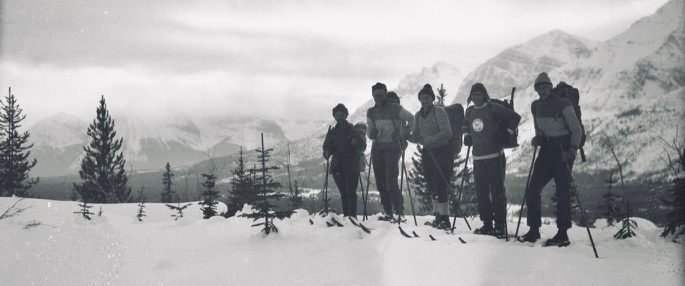First World War veteran Frank Burstrom Sr. was a Park Warden in the early years of Jasper National Park and undisputedly one of the most gifted Nordic skiers who ever called Jasper home. His herculean endurance and effortless glide carried his well-worn skis into deep powder fields, over glittery passes and across the undiscovered ski wilds of Jasper and Banff National Parks.
After surviving WWI as possibly the youngest known soldier in Canadian military history, Burstrom finally traded his combat-issued weapon for a pair ski poles. His Norwegian bloodline surged into action and Frank the skier was off. The 1920s and 30s were an exciting time in the mountain parks; skis and skiing had stuck like klister. The sport was surging on the long wooden skis of Scandinavian immigrants, many of whom were displaced from war and poverty and who were seeking a better life.
These passionate souls shared their knowledge with the locals who quickly realized that skiing was a lot of fun. Skiing brought exploration, companionship and an opportunity to dip the tips into powder fields, over mountain passes and down sublime slopes.

Banff had their hotshot skiers, but Jasper’s skiers were a special breed of their own. There was Joe Weiss, a focused mountain guide from Switzerland; the Jeffery brothers, Vern and Doug, who learned how to ski while attending high school in Revelstoke; and Pete Withers, a park warden, who has been called the first recreational skier in Jasper and is credited with the first winter exploration of the Maligne valley in 1919. Frank Burstrom, with his athlete aptitude and silent toughness, rounded out this gang of youthful ski explorers. These were the hardcore, uber-athletes decades before these terms were coined.
Frank was not only a member of the Jasper Ski Club (JSC) but was also registered with the Canadian Amateur Ski Association. He competed in many Nordic events in Jasper and Banff throughout the 1920s and ‘30s. A favourite had to be the “marathon” ski race, which took participants on a 40 km tour from Maligne Canyon up to Medicine Lake and back on a widened wagon road. There are still fragmented sections of this wagon road and if you listen closely, you can still hear the laboured breaths of skiers.

When Frank wasn’t working or competing, he was skiing—either with the guys or on his own. He took multiple sojourns into the Tonquin Valley and countless tours into the unexplored ski bonanza of the Maligne Valley. Burstrom was also known for being part of the first ever ski traverse from Jasper to Banff. In 1930, with his friends Joe Weiss, Pete Withers and Doug and Verne Jeffery, Burstrom left Jasper on January 15. After combating bitterly cold temps (-50 degrees Fahrenheit), deep snow, poor maps and the usual disarray of ski travel, the party arrived in Banff on January 30, just in time for the famous Winter Carnival. Elated, exhausted, heavily whiskered, sunburnt and needing a bath, the story goes that Frank still had some gas in the tank and, unbelievably, entered a 20 mile race soon after.
But it was their 15 day, 300 km traverse, which followed the Icefields Parkway, that not only made history, it ignited the imagination of endurance skiers and opened the portal to future ski traverse endeavors.
One of those whose eyes were opened to the magic of Rockies skiing was Erling Strom.



Strom was a Norwegian living in Lake Placid, New York who showed up in Banff in 1928 with skis a- blazing and his keen eye searching for skiing opportunities. He was focused on backcountry skiing at Banff’s incomparable Mount Assiniboine and so began a glorious ski lodge era. Assiniboine (1928), Sunshine (1929) and Skoki (1931) were all built around the time Strom showed up. A fierce, long distance skiing competitor, Strom was impressed with Jasper’s Frank Burstrom.
The early 1930’s skiing accomplishments kept exploding; not only did the Jasper Five complete the first ever Jasper to Banff ski traverse, another group of seven, including locals Joe Weiss, Doug Jeffery and the indomitable Strom, set out from Jasper on another long ski journey. Two days later they reached the Brewster Chalet at Maligne Lake, where unfortunately, Joe broke a ski. This was a dilemma, for which Joe had no solution other than to use the telephone in the nearby warden cabin and call Frank. Weiss knew this was a nearly impossible request, but he had to ask: Could Burstrom ski up to Maligne Lake with an extra ski?

What a favour this was! A whopping 60 mile (100km) round trip on a moment’s notice. After much negotiating, Frank finally agreed and, true to his word, showed up at the cabin six hours later. Almost immediately he was heading back to Jasper. There are very few skiers today, with all of our modern equipment and light-weight travel gear, who could duplicate this feat.
Yes, the moon was out, the track was good and the snow was just right, but why was he so insistent on returning the same night? Burstrom’s answer is probably one of the most endearing quotes in ski history: “But it was necessary; I was getting married that morning at ten o’clock”.
Erling Strom later wrote “we knew we had picked a good man, but what I found out about him 14 days later made me think he was the best man I had ever met.”
Frank Burstrom’s story and many more have contributed to Jasper National Park’s ski history. These are remarkable individuals—a breed of special mountain souls whose pioneer skiing accomplishments have to be recognized, revered and repeated.
Former Olympic skier Loni Klettl is a writer and trail ambassador in Jasper, AB


